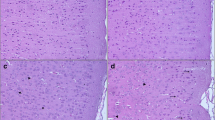Summary
Experimental lead encephalopathy was produced in developing rats. The cerebellar changes that developed were studied by light and electron microscopy. Although edema was observed in all phases of the encephalopathy, changes in the blood vessels, formation of platelet thrombi, and alterations of the Purkinje cells and their dendrites warranted special attention. The lead and calcium content of the brain and of the blood in the lead poisoned and control groups were determined chemically. The results are discussed from a morphological point of view and a hypothesis of their pathogenesis is presented.
Zusammenfassung
Wir haben bei neugeborenen Ratten eine experimentelle Blei-Encephalopathie hervorgerufen und die cerebellaren Veränderungen licht- und elektronenmikroskopisch untersucht. In allen Stadien der Encephalopathie war ein Ödem vorhanden, darüber hinaus fanden sich Anzeichen für Capillarschäden, Bildung von Plättchenthromben und Veränderungen der Purkinje-Zellen mit ihren Dendriten. Blei- und Calciumgehalt des Gehirnes wie des Blutes von bleivergifteten Ratten und von Kontrolltieren wurden chemisch untersucht. Die Ergebnisse werden aus der Sicht des Morphologen besprochen, die Pathogenese der Veränderungen diskutiert.
Similar content being viewed by others
References
Aub, J. C., Fairhill, L. T., Minot, A. S., Reznikoff, P.: Lead poisoning. Medicine (Baltimore) 4, 1–250 (1925).
Bakay, L., Lee, J. C.: Cerebral edema. Springfield, Illinois U.S.A.: C. C. Thomas Publishers 1965.
Bauer, K. Fr., Vester, G.: Das elektronenmikroskopische Bild der Hirnkapillaren menschlicher Föten. Fortsch. Neurol. Psychiat. 38, 270–318 (1970).
Colmant, H. J.: Zerebrale hypoxie, p. 19–22. Stuttgart: Georg Thieme 1965.
Hassin, G. B.: The contrast between brain lesions produced by lead and other inorganic poisons and those caused by epidemic encephalitis. Arch. Neurol. Psychiat. (Chic.) 6, 268–285 (1921).
Hills, C. P.: Ultrastructural changes in the capillary bed of the rat cerebral cortex in anoxic-ischaemic brain lesions. Amer. J. Path. 44, 531–552 (1964).
Himwich, H. E., Fazekas, J. F.: Comparative studies of the metabolism of the brain of infant and adult dogs. Amer. J. Physiol. 132, 454–459 (1941).
Hirsch, H., Breuer, M., Künzel, H. P., Marx, E., Sachweh, D.: Über die Bildung von Thrombozytenaggregaten und die Änderung des Hämatokrits durch Komplete Gehirnischämie. Dtsch. Z. Nervenheil. 186, 58–66 (1964).
Lampert, P., Garro, F., Pentschew, A.: Lead encephalopathy in suckling rats.—An electron microscopic study, p. 207–222. Brain edema, ed. Klatzo, I. and Seitelberger, F. Wien—New York: Springer-Verlag 1967.
McLaurin, R. L., Nichols, J. B.: Extensive cranial decompression in the treatment of lead encephalopathy. Pediatrics 20, 653–667 (1957).
Okazaki, H., Aronson, S. M., Di Maio, D. J., Oliviera, J. E.: Acute Lead encephalopathy of childhood. Histologic and chemical studies with particular reference to angiopathic aspects. Trasn. Amer. neurol. Ass. 88, 248–250 (1963).
Pentschew, A., Garro, F.: Lead encephalomyelopathy of the suckling rat and its implications on the porphyrinopathic nervous diseases. Acta neuropath. (Berl.) 6, 266–278 (1966).
Schulz, H., Rabanus, B.: Die kapilläre Plättchenthrombose im elektronenmikroskopischen Bild. Ziegler's Beiträge 131, 290–311 (1965).
Torack, R. M.: Ultrastructure of the capillary reaction to brain tumours. Arch. Neurol. (Chic.) 5, 416–428 (1961).
Totovic, V.: Elektronenmikroskopische Befunde in der Niere bei chronischer Bleivergiftung der Ratte. Verh. Dtsch. Ges. Path. 48. Tagg. 193–197 (1964).
Tyler, D. B., Harreveld, A. Van: The respiration of the developing brain. Amer. J. Physiol. 136, 600–603 (1942).
Ule, G., Kolkmann, F. W., Brambring, P.: Experimentelle elektronenmikroskopische Untersuchungen zur formalen Pathogenese der Wernickeschen Encephalopathie. Klin. Wschr. 17, 886–887 (1967).
Watrach, A. M.: Degeneration of mitochondria in lead poisoning. J. Ultrastruct. Res. 10, 177–181 (1964).
Author information
Authors and Affiliations
Additional information
This work was supported by the Deutsche Forschungsgemeinschaft.
, St. John's Medical College, Bangalore 34, India.
Rights and permissions
About this article
Cite this article
Thomas, J.A., Dallenbach, F.D. & Thomas, M. Considerations on the development of experimental lead encephalopathy. Virchows Arch. Abt. A Path. Anat. 352, 61–74 (1971). https://doi.org/10.1007/BF00549764
Received:
Issue Date:
DOI: https://doi.org/10.1007/BF00549764




